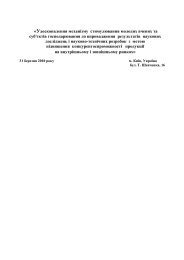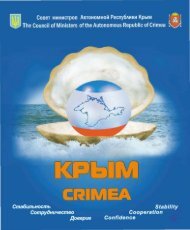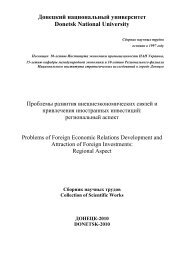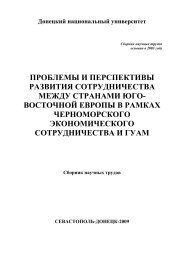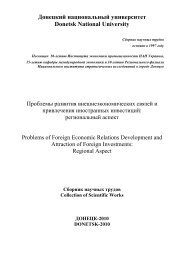Проблемы развития внешнеэкономических связей и привлечения иностранных инвестиций: региональный аспект, 2010Таким образом, каждый результат по каждой сомнительной альтернативе взвешивается по двум этим критериям. На что решитсяоперирующая сторона, зависит от ее отношения к риску, от того, в каких пропорциях она готова обменять дополнительные порции риска надополнительные порции выигрыша.СПИСОК ИСТОЧНИКОВ1. Мелкумов Я.С. Экономическая оценка эффективности инвестиций/ Мелкумов Я.С. – М.: ИКЦ «ДИС», 1997. – 159с.2. Первозванский А.А. Финанасовый рынок: расчет и риск / Первозванский А.А., Первозванская Т.Н.. – М.: Инфра – М,1994.- 235c.3. Ковалев В.В. Финансовый анализ / Ковалев В.В. – М.: Финансы и статистика, 1995. – 511с.4. Капитоненко В.В. Финансовая математика и ее приложения / Капитоненко В.В.. – М.: Изд-во ПРИОР, 1998.-139сРЕЗЮМЕВ работе рассмотрена задача принятия решений в условиях неопределенности и риска. Доказан принцип равновероятности принятия решений вусловиях неопределенности. Показано его применение для решения задачи диверсификации инвестирования в различные депозиты.РЕЗЮМЕУ роботі розглянута задача ухвалення рішень в умовах невизначеності і ризику. Доведений принцип рівноймовірності ухвалення рішень вумовах невизначеності. Показано його застосування для вирішення задачі диверсифікації інвестування в різні депозити.SUMMARYThe task of acceptance of decisions in the conditions of vagueness and risk is considered in work. Principle of equilibrate acceptance of decisions in theconditions of vagueness is proved. His application for the decision of task of diversification of investing in different deposits is shown.MODERN TENDENCIES OF EXPORTING OF GEORGIALekashvili E., Doctor of Economics, Associate Professor, Faculty of Economics and Business, Ivane Javakhishvili Tbilisi State UniversityTbilisi,Georgia ⋅Currency of the problem: Fundamental and systemic economic changes in Georgia consider transition to market economy, development of open economyand involvement in world economic space. The main result of the mentioned changes is the establishment of business entities with competitive productionat world market. In the course of the period of open economy development and transition to market economy, several problems were revealed, and one ofsuch problems is deficit of knowledge of right orientating at foreign markets. Deficit of knowledge especially has been especially revealed recently, underthe conditions of Russian embargo on Georgian wines and mineral waters and unavailability to export Georgian products at the EU and other foreignmarkets.Trade is holding fundamental place in foreign economic activities of Georgia and thus currency of the research subject is doubtless.Georgian companies are broadening foreign relations that are reflected in the growth of export. According to the Statistics Department of Georgia tradebalance of goods and services of Georgia in 2004-2008YY increased from -$1198.7 million to -$4808.5 million, while the mentioned rate in 2009 madeup -$1761.4 million (See Table No 1).The number of foreign trade partners is increasing both in developed and developing countries. However, the top ten trade partners (in export) for Georgiaare: Turkey, Azerbaijan, Canada, Bulgaria, Ukraine, Armenia, USA, Italy, Russia and Greece.Table No 1 - Foreign Trade of Georgia, 2004-2009 January-July, Million USD2004 2005 2006 2007 2008 2009 January-JulyForeign Trade Turnover 2492.5 3355.4 4613.9 6447.3 7800.6 2996.0Registered Export of Goods (FOB) 646.9 865.5 936.2 1232.4 1496.1 617.3Registered Import of Goods (CIF) 1845.6 2490.0 3677.7 5214.9 6304.6 2378.7Foreign Trade Balance -1198.7 -1624.5 -2741.5 -3982.5 -4808.5 -1761.4Source: www.statistics.geThe essence of the problem is that in January-June of 2009, almost 80,5% of export was made from these 10 main countries (Previous years arecharacterized with the same rates: 82,3% - in 2001, 83,7% - in 2002, 82,4% - in 2003, 80,1% - 2004, approximately 94% from 6 countries - in 2005, and95% from 6 countries in 2006. Despite the fact that export volume was increasing in the mentioned countries, non-diversification of commodity structureof export and markets restricts prospects of export’s further development. It should be noted that increase of the number of partners defined growth ofcompetition among contractors that is determining factor for increase of export effectiveness.Export quota is one of the factors that reveal existing problems in exporting field of Georgia. Export quota indicates export volume correlation with thecountry’s GDP in percentage. Export quota rate was characterized with the reduction tendency in 2004-2008 (See, Table No 2) that indicates the reductionof the share of export incomes in the country’s GDP (See Diagram No 1).Table No 2. Gross Domestic Product of Georgia, Export (Million USD) and Export Quota (%) 1 , 2004-2008YYYearsGross Domestic Export Export Quota, %Product2004 5 124 696.9 13.62005 6 411 865.5 13.52006 7 761 936.2 12.02007 10 171 1 232.4 12.12008 12 798 1 496.1 11.6Permanent change of export-import structure of the country for benefit of imports clarifies that terms of trade of Georgia are continually worsening: theprices of the main exported commodities of Georgia are fallen, while majority of the enterprises producing these products are stopped or hardly working.Foreign trade turnover of Georgia in January-July of 2009 (without unorganized trading) was $2996.0 million that is 37% less compared to the same indexof previous year; Export out of this is $617.3 million (35% less), while import - $2378.7 million (37.8% less). In January-July of 2009, negative tradebalance of Georgia is $1761.4 million (correspondingly 38.6%) 2 . It is seen from the data that foreign trade indices are sharply worsened in comparisonwith the same period of previous year.© Lekashvili E., 20101 Table is designed based on the data of the Statistics Department of the Ministry of Economic Development of Georgia2www.statistics.ge52
Проблемы развития внешнеэкономических связей и привлечения иностранных инвестиций: региональный аспект, 2010Diagram N 1. Export Quota of Georgia, %, 2004-2008YYIn January-July of 2009, Georgia has negative trade balance with 98 partner countries and positive trade balance with 22 countries. Trade turnover ofGeorgia with the EU countries has decreased, export made up $127.0 million (42.9% less), and import - $706.7 million (35.4% less). 1According to the data of Statistics Department of Georgia, the share of top ten partner countries in aggregate foreign trade turnover is 68.1% for the periodof January-July 2009. Major trade partners of Georgia are Turkey, Azerbaijan, Ukraine, Germany, Russia, USA, Bulgaria, Italy, China, and Armenia.Major trade partner countries of Georgia in export are Turkey, Azerbaijan, Canada, Armenia, Bulgaria, Ukraine, USA, Russia, Italy, and United Emiratesof Arabia. These countries hold 80% of total export volume.It is obvious that Geographical structure of Georgian export mainly covers countries and markets of strategic partners in one Geographical region.There are different tendencies of export indices with major trade partners in 2008 compared with previous year. Export volume in Bulgaria increased from$59 357 to $108 217; from $171 764 to $262 910 in Turkey; from $137 455 to $204 534 in Azerbaijan; from $110 844 to $123 422 in Armenia; from$70 604 to $131 806 in Canada. Export volume in USA has decreased from $149 036 to $102 198 in 2008 compared with the data of previous year 2 .Turkey is Georgia’s biggest trade partner country by the foreign trade turnover of January-July of 2009. Trade turnover with Turkey is $589.8 million thatis 16.7% less compared with the previous year’s rate. Share of trade turnover with this country increased by 4.9% and made up 19.7%. Export to Turkey is$143.4 million that is only 76.7% of the same rate of previous year. Export of ferrous metal scrap-iron and nitric fertilizer is reduced. However, export ofsuch commodity groups as seed wheat of oil crops, ferroalloy and cotton cake.Trade turnover with Azerbaijan is $296.1 million that is 60.1% of previous year rate. The share of trade turnover with Azerbaijan has decreased from10.3% to 9.9%. In the accounting period, in comparison with the previous year, export in Azerbaijan is decreased by $33.3 million. Major exportcommodity groups are passenger cars and cement. Ukraine is holding third place in the top ten of Georgia’s trade partners. Trade turnover with thiscountry is $272.7 million that is 59.3% of previous year rate.Share of trade turnover with Ukraine has decreased by 0.5 percentage points - from 9.6% to 9.1%. Export is reduced by $27.4 million. This was mainlyresulted in export volume decrease of the following commodity groups: ferroalloy, wines and apple. Export of alcoholic beverages is increased and itamounts $17.9 million.Ferroalloy is holding first place in export top ten commodities, with 12.9% of total export and $79.9 million. Crude and semi crude gold export amounts$62.8 million that is 10.2% of total export. Export of third commodity group - passenger cars has decreased by $19.9 million and made up $49.9 million 3 .In the recent years, share of separate commodity groups are increasing, instead of variety of commodity types exported. As a result, country’s exportpotential strongly depends on few commodities (ferroalloy, scrap iron, copper ore, fertilizers, nuts).Presented analysis makes obvious the sharpness of the problems existing in export of Georgia and reveals the currency of their studying. There aredifficulties, both in export production and its organization and management.LIST OF REFERENCES:1. European Commission (2004) Flash Euro barometer; Entrepreneurship, European Union Economics, Fifth Edition, Theo Hitiris, Prentice Hall, 20032. Getting Started in Export Trade, International Trade center, UNICTAD/WTO, Geneva3. Carl Nelson, Import/Export: How to Get Started in International Trade4. Exporting, Importing and Beyond, Lawrence W. Tuller, Adams Media Corp.5. Principles and Practice of Exporting, Study Guides, University of Lincolnshire and Humberside, By Geoff Cook6. Krugman P., Obstfeld M., International Economics: Theory and Policy. Ed. 3-9, Chapter7. Doha Declaration, WTO,2008, ISBN 978-92-870-3447-2, p.978. WTO Discussion Papers, WTO, N2, Improving the Availability of Trade Finance during Financial Crisis, 2009 - III9. WTO Discussion Papers, WTO, N1, Industrial Tariffs and the Doha Development Agenda, 2009-I10. WTO Discussion Papers, WTO, N4, The Role of Export Taxes in the Field of Primary Commodities; 2004-VII11. WTO-Annual Report, 200812. Р. Гриффин, М. Пастей, Международный Бизнес, Питер, 200613. Т.А.Пугель, П.Х.Линдерт, Международная экономика, М., 200314. П. Кругман, М.Обстфельд. Международная экономика. Теория и политика. М., 200315. А.Киреев. Международная экономика, части 1,2. М., 1997/9916. Ф. Аналоуи,А.Карами,Стратагический менеджмент малых и средних предприятий,пер.с англ.М., 2005РЕЗЮМЕВ статье рассмотрены современные тенденции развития экспорта Грузии.РЕЗЮМЕУ статті розглянуті сучасні тенденції розвитку експорту Грузії.SUMMARYIn article modern lines of development of export of Georgia are considered.1www.statistics.ge2Statistics Department of the Ministry of Economic Development of Georgia; Statistical publication, analysis of foreign trade indices of Georgia, Tbilisi2009, page 133Foreign Trade of Georgia, January-July 2009, Page 2-3, www.statistics.ge53
- Page 1 and 2: Донецкий националь
- Page 3 and 4: Редакционная колле
- Page 5 and 6: Проблемы развития
- Page 7 and 8: Проблемы развития
- Page 10 and 11: Проблемы развития
- Page 12 and 13: 12Проблемы развития
- Page 14 and 15: Проблемы развития
- Page 16 and 17: Проблемы развития
- Page 18 and 19: 18Проблемы развития
- Page 20 and 21: Проблемы развития
- Page 22 and 23: Проблемы развития
- Page 24 and 25: Проблемы развития
- Page 26 and 27: 26Проблемы развития
- Page 28 and 29: Проблемы развития
- Page 30 and 31: Проблемы развития
- Page 32 and 33: Проблемы развития
- Page 34 and 35: Проблемы развития
- Page 37 and 38: Проблемы развития
- Page 40 and 41: 40Проблемы развития
- Page 42 and 43: Проблемы развития
- Page 44 and 45: Проблемы развития
- Page 46 and 47: 46Проблемы развития
- Page 48 and 49: 48Проблемы развития
- Page 50 and 51: Проблемы развития
- Page 54 and 55: Проблемы развития
- Page 56 and 57: 56Проблемы развития
- Page 58 and 59: Проблемы развития
- Page 60 and 61: РКрим А і н ницькаВ
- Page 62 and 63: Проблемы развития
- Page 64 and 65: содействия поФондМ
- Page 66 and 67: Проблемы развития
- Page 68 and 69: 68Проблемы развития
- Page 70 and 71: 70Проблемы развития
- Page 72 and 73: Проблемы развития
- Page 74 and 75: Проблемы развития
- Page 76 and 77: 76Проблемы развития
- Page 78 and 79: 78Проблемы развития
- Page 80 and 81: 80Проблемы развития
- Page 82 and 83: Проблемы развития
- Page 84 and 85: 84Проблемы развития
- Page 86 and 87: Проблемы развития
- Page 88 and 89: Проблемы развития
- Page 90 and 91: Проблемы развития
- Page 92 and 93: Проблемы развития
- Page 94 and 95: Проблемы развития
- Page 96 and 97: Проблемы развития
- Page 98 and 99: 98Проблемы развития
- Page 100 and 101: Проблемы развития
- Page 102 and 103:
102Проблемы развити
- Page 104 and 105:
Проблемы развития
- Page 106 and 107:
Проблемы развития
- Page 108 and 109:
Проблемы развития
- Page 110 and 111:
Проблемы развития
- Page 112 and 113:
Проблемы развития
- Page 114 and 115:
60000700004000050000200003000001000
- Page 116 and 117:
Проблемы развития
- Page 118 and 119:
Проблемы развития
- Page 120 and 121:
Проблемы развития
- Page 122 and 123:
Проблемы развития
- Page 124 and 125:
Проблемы развития
- Page 126 and 127:
Проблемы развития
- Page 128 and 129:
01 ж ивi тварини55 хiмi
- Page 130 and 131:
Проблемы развития
- Page 132 and 133:
Проблемы развития
- Page 134 and 135:
Проблемы развития
- Page 136 and 137:
136Проблемы развити
- Page 138 and 139:
Проблемы развития
- Page 140 and 141:
Проблемы развития
- Page 142 and 143:
Проблемы развития
- Page 144 and 145:
Проблемы развития
- Page 146 and 147:
Проблемы развития
- Page 148:
Проблемы развития
- Page 151 and 152:
Проблемы развития
- Page 153 and 154:
Проблемы развития
- Page 155 and 156:
Проблемы развития
- Page 157 and 158:
Проблемы развития
- Page 159 and 160:
Проблемы развития
- Page 161 and 162:
Проблемы развития
- Page 163 and 164:
Проблемы развития
- Page 165 and 166:
Проблемы развития
- Page 167 and 168:
Проблемы развития
- Page 169 and 170:
Проблемы развития
- Page 171 and 172:
Проблемы развития
- Page 173 and 174:
Проблемы развития
- Page 175 and 176:
Проблемы развития
- Page 177 and 178:
Проблемы развития
- Page 179 and 180:
Проблемы развития
- Page 181 and 182:
Проблемы развития
- Page 183 and 184:
Проблемы развития
- Page 185 and 186:
Проблемы развития
- Page 187 and 188:
Проблемы развития
- Page 189 and 190:
Проблемы развития
- Page 191 and 192:
Проблемы развития
- Page 193 and 194:
Проблемы развития
- Page 195 and 196:
Проблемы развития
- Page 197 and 198:
Проблемы развития
- Page 199 and 200:
Проблемы развития
- Page 201 and 202:
Проблемы развития
- Page 203 and 204:
4748,14039,3Проблемы раз
- Page 205 and 206:
Проблемы развития
- Page 207 and 208:
Проблемы развития
- Page 209 and 210:
Проблемы развития
- Page 211 and 212:
Проблемы развития
- Page 213 and 214:
Проблемы развития
- Page 215 and 216:
Проблемы развития
- Page 217 and 218:
Проблемы развития
- Page 219 and 220:
Проблемы развития
- Page 221 and 222:
Проблемы развития
- Page 223 and 224:
Проблемы развития
- Page 225 and 226:
Проблемы развития
- Page 227 and 228:
Проблемы развития
- Page 229 and 230:
Проблемы развития
- Page 231 and 232:
Проблемы развития
- Page 233 and 234:
Проблемы развития
- Page 235 and 236:
Проблемы развития
- Page 237 and 238:
Проблемы развития
- Page 239 and 240:
Проблемы развития
- Page 241 and 242:
⌢Проблемы развити
- Page 243 and 244:
Проблемы развития
- Page 245 and 246:
Проблемы развития
- Page 247 and 248:
Проблемы развития
- Page 249 and 250:
Проблемы развития
- Page 251 and 252:
Проблемы развития
- Page 253 and 254:
Проблемы развития
- Page 255 and 256:
Проблемы развития
- Page 257 and 258:
Проблемы развития
- Page 259 and 260:
Проблемы развития
- Page 261 and 262:
Проблемы развития
- Page 263 and 264:
Проблемы развития
- Page 265 and 266:
Проблемы развития
- Page 267:
−−−−Проблемы раз
- Page 270:
Проблемы развития
- Page 273 and 274:
Проблемы развития
- Page 275 and 276:
Проблемы развития
- Page 277 and 278:
Проблемы развития
- Page 279 and 280:
Проблемы развития
- Page 281 and 282:
Проблемы развития
- Page 283 and 284:
Проблемы развития
- Page 285 and 286:
Проблемы развития
- Page 287 and 288:
Проблемы развития
- Page 289 and 290:
Проблемы развития
- Page 291 and 292:
Проблемы развития
- Page 293 and 294:
Проблемы развития
- Page 295 and 296:
Проблемы развития
- Page 297 and 298:
Проблемы развития
- Page 299 and 300:
Проблемы развития
- Page 301 and 302:
Проблемы развития
- Page 303 and 304:
Проблемы развития
- Page 305 and 306:
Проблемы развития
- Page 307 and 308:
Проблемы развития
- Page 309 and 310:
Проблемы развития
- Page 311 and 312:
Проблемы развития
- Page 313 and 314:
Проблемы развития
- Page 315 and 316:
Проблемы развития
- Page 317 and 318:
Проблемы развития
- Page 319 and 320:
Проблемы развития
- Page 321 and 322:
Проблемы развития
- Page 323 and 324:
Проблемы развития
- Page 325 and 326:
Проблемы развития
- Page 327 and 328:
Проблемы развития
- Page 329 and 330:
Проблемы развития
- Page 331 and 332:
Проблемы развития
- Page 333 and 334:
Проблемы развития
- Page 335 and 336:
Проблемы развития
- Page 337 and 338:
Проблемы развития
- Page 339 and 340:
Проблемы развития
- Page 341 and 342:
Проблемы развития
- Page 343 and 344:
Проблемы развития
- Page 345 and 346:
Проблемы развития
- Page 347 and 348:
Проблемы развития
- Page 349 and 350:
Проблемы развития
- Page 351 and 352:
Проблемы развития
- Page 353 and 354:
РАЗВИТИЕ ВНЕШНЕЭКО
- Page 355 and 356:
Морозова О.В. ДИСБА
- Page 357 and 358:
УКРАИНЕШумак Ж.Г.ПР
- Page 359 and 360:
КРИЗИВорошилова Г.
- Page 361 and 362:
Именной указатель/
- Page 363 and 364:
Костенко Н.В. 1 71Кош
- Page 365 and 366:
Ступницький О.І. 3 784



